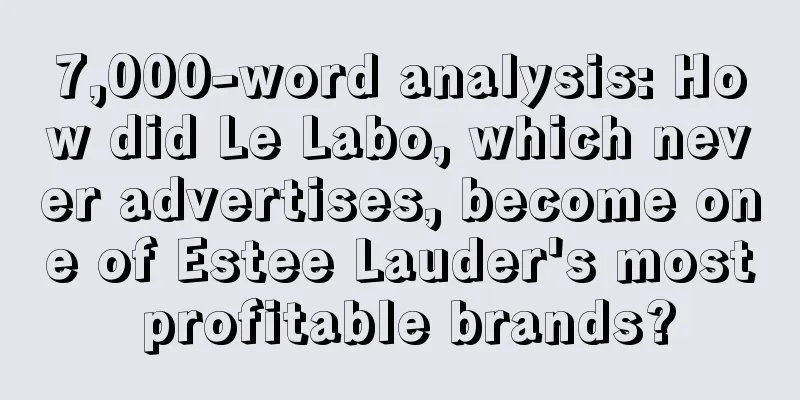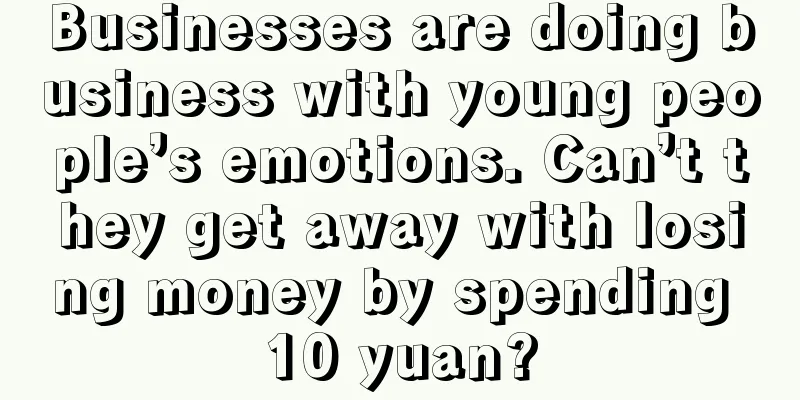7,000-word analysis: How did Le Labo, which never advertises, become one of Estee Lauder's most profitable brands?

After two months of preheating, on June 1, the salon fragrance brand "Le Labo" finally opened its first brand store in mainland China, located in the Shikumen of Xintiandi. According to store visits, the new store was crowded with people, with queues lasting more than 30 minutes, and most products were sold out by noon. After studying Le Labo, I found that it is a brand that has solved the "commercialization" problem of salon fragrances very well. On the one hand, commercially, it has not made a loss since the third month after the opening of the brand's first store; it was acquired by Estee Lauder in 2014 and was described by the group's CEO Fabrizio Freda as "one of the most promising perfume brands"; in the fourth quarter of last year, when the performance of the group's various business segments declined sharply, its net sales grew strongly by double digits. Estee Lauder 2023 Q3 Financial Report On the other hand, it has created an exclusive experience of "each bottle of perfume is blended on-site in the store", and has a wide range of fans around the world. Even if some products are priced at more than US$700 per bottle, they are quickly sold out after they are released. And to achieve such results, it has hardly done any advertising. Le Labo on-site mixing map What did Le Labo do right and when to become what it is today? After a detailed investigation, DaoFa found that Le Labo actually fully implemented the potential energy strategy of lifestyle brands:
We have read through almost all the information we could find at home and abroad, and analyzed in detail the details such as the founding team, brand positioning, product creation, and retail experience, and found out how Le Labo implemented the above-mentioned strategy and stood out from the crowd. 1. Two senior fragrance practitioners use the logic of luxury goods to make perfume1. Background: The rise of niche perfume in the United StatesBefore the 21st century, the fragrance market was flooded with mass-market perfumes. The logic was to conduct market research first, find the scent that might sell best, then mass-produce it, add gorgeous packaging, market it on a large scale, and use the celebrity effect to sell the product. However, as globalization spread more and more widely at that time, excessive commercialization stimulated the opposite demand of a group of people. At the same time, with the rise of postmodernism, the public held high the banner of "individualism", advocating freedom, full deconstruction, suspicion of everything, and opposition to authority. Ben Gorham, founder of the salon fragrance Byredo, which was founded in 2006, once said: "In the past, people bought perfume to adapt to the environment and make themselves part of the group, but now the situation is exactly the opposite. Perfume must help them express their unique personality." This cultural atmosphere is also reflected in the fragrance market. According to Euromonitor data, since 2000, the sales of mass-market perfumes (including celebrity perfumes) in the United States have been declining, and the volume has been halved within a few years, while the scale of niche salon perfumes has begun to rise. At that time, New York, as the fashion capital of the world, brought together a variety of cultures. The city was very inclusive, and each style could find its place while retaining its cultural characteristics. People were used to seeing new things and were not afraid to try them. More importantly, New York had a large number of fashion media, and their reports had a great impact worldwide. So, in 2006, in New York, Edouard Roschi and Fabrice Penot left the high-end fragrance business of the L'Oréal Group, where they had worked for many years, and opened the first Le Labo store. Le Labo's first store in New York 2. Team: L’Oréal senior executives leave factory to start their own businessThese two people have very impressive backgrounds, with basic knowledge of chemistry and business literacy. They have worked in the industry's leading fragrance companies for more than 10 years and have also created products from 0 to 1 for high-end fragrance brands. When they left, they had already reached senior management positions and had control over many channels and media resources. One of the founders, Edouard Roschi, studied chemical engineering at university, but he did it to make his parents happy rather than to become a scientist. After graduation, he was introduced by a friend to work for Firmenich (one of the world's four largest fragrance suppliers) in Switzerland. As an account director, he was responsible for the sales of "functional" fragrance products such as shampoo and detergent in the North African and Middle Eastern markets. He had great business autonomy and could "do almost anything he wanted." After working at Firmenich for ten years, he went to London to study for an MBA and moved to L'Oréal in 2000, where he began working in the Giorgio Armani fragrance department. It was here that he met his future partner Fabrice Penot, who had worked at Symrise (one of the four major fragrance suppliers in another world) before joining L'Oréal, where he was the main developer of the group's high-end fragrance lines Armani Privé and Acqua di Gio. Founder of Le Labo The main content of their work is to develop a perfume from scratch, including determining the story, packaging, communicating with perfumers, publicity and distribution, etc. The position is very high and they report directly to Armani himself. But working in a large company, teamwork is very important, and processes are often difficult to promote. The biggest feeling of the two people at that time was that their professional ability was getting stronger and stronger, but their creativity was always diluted by some political and commercial factors. Many people came to tell them "You shouldn't do this." They also have a lot of complaints about the modern fragrance market. In their opinion, this industry is too "lacking courage" and creativity often gives way to more certain commercial results. But in their hearts, creation comes first. With the combined effect of these factors, they decided to leave the big company and start their own business, challenge the existing business model, and make a perfume that can re-excite the market. Unlike the commercial fragrances that were flooding the market at the time, they wanted to make a "luxury perfume". 3. Logic: Craftsmanship first, respect for creationLuxury brands will not tell others that their products are great or amazing. Their logic is "craftsmanship first". They talk about ingredients and raw materials, who discovered them, and how these people incorporate their stories into the products. Therefore, Le Labo tries to maximize the value of perfumers’ work. In Eddie’s words, “This is the sexiest part of perfume.” In order to ensure the quality of the perfume, Le Labo gives perfumers ample creative space and uses raw materials that are 30 times better than ordinary perfumes. They likened the relationship between themselves and perfumers to that of a "director and photographer", giving the perfumers they collaborated with great freedom. Because they had worked for Firmenich and Symrise for several years, they never used bidding to select partners, as they felt that it would "kill creativity". Instead, they chose to use perfumers they were familiar with and work with them one-on-one to avoid unnecessary communication costs when working as a team. Take the brand's first fragrance, Rose 31, for example. It is known as the best rose fragrance in the world and accounted for 60% of the brand's sales in the early days. Chandler Burr, perfume critic for The New York Times, commented on it as "elegant and sexy." Rose 31 Raw Materials Perfumer Daphne Bugey once shared her feelings about working with the founder:
Ultimately, the fragrance took two years to develop, and once the product was ready, Le Labo opened the brand's first store in 2006 in a small shop on Elizabeth Street in NoLita, New York. The first store only sold 9 perfumes and 1 candle, with each bottle of perfume priced at US$200, which was twice the price of many big-name perfumes at the time. In order to better enhance the production process, Le Labo's perfumes are prepared on site. After the user chooses the scent they like, the store's perfumer mixes essential oils, alcohol and water in proportion and puts them into bottles. This model was very novel, but it was successful in New York in 2006. Two months after the opening of the first Le Labo store, the brand achieved balance. To this day, we can still find responses about the opening of the first Le Labo store on the Internet - although many people think they are unusual, they still hold an attitude of expectation and optimism. New York First Store Online Reviews Three months after opening, thanks to the team's own media resources, W magazine published a full-page report on the brand, followed by The New York Times. Driven by the leading media, lifestyle magazines and bloggers began to write articles about Le Labo; high-end brands such as Gramercy Park Hotel in the heart of Manhattan and lifestyle chain Anthropologie began to seek cooperation with it. Subsequently, Le Labo began to embark on a smooth global expansion journey. 4. Expansion: Keep the pace and launch new products cautiouslyMass products can drive sales by constantly launching new products, but in the luxury perfume industry, in Eddie's words, "It's not about launching new products, but about launching the right things." From 2006 to now, the number of the brand's perfumes has only increased from 9 to 19, with an average of less than 1 new perfume launched each year. Le Labo official website product list In addition to basic styles, Le Labo has also launched a special series of 14 city-limited fragrances, which are released in September every year. Campell, the trainer of the brand, explained that this series is a fight against the "globalization of luxury experience", because the higher level of luxury experience cannot be obtained by spending money alone. Each city-limited Le Labo must be purchased by users in person at the offline store in that city, and the price is as high as US$718/100ml. Even after being acquired by Estee Lauder in 2014, LeLabo still maintains its brand independence and retains autonomy in developing new products and opening new stores. Estee Lauder does not intervene in front-line business, but mainly plays a role in supporting the independent operation of brand business at the back end. From a business perspective, Estée Lauder had asked Le Labo to launch five new scents every year, but Edouard told them, "I won't do what you ask." 2. Wabi-sabi is more suitable for the mind, body and soul culture of the middle class1. Wabi-sabi aesthetics advocates "imperfection is truth"The core of a brand is psychological imprinting. We are willing to wear perfume not only because it smells good, but because after wearing it, it becomes a representative of a certain idea that you support. The book "Cultural Strategy" mentions that by establishing a strong connection between the brand and the ideology generated by social and historical changes, it can help build brand barriers. Simply put, the brand leverages the power of a specific national culture, historical culture, or even some circle culture, subculture, etc. to promote the brand and make users more loyal. For example, Nike captured the essence of the "American Dream" and proposed that running can help people regain their competitive spirit; Apple used the famous "Think Different" advertisement to pay tribute to creators who are not satisfied with the status quo. Le Labo is no exception. The two founders were deeply influenced by the Japanese Wabi-Sabi culture. Wabi-Sabi is a broadly speaking aesthetic concept that describes the beauty of the impermanent, impermanent and transient. It is more of a feeling that is difficult to explain clearly. Some critics believe that once you start to explain it, the characteristics of Wabi-Sabi will begin to be lost. As the famous Japanese Zen researcher and thinker Daisetz Suzuki said, "Incomplete forms and imperfect food can better express the spirit, because too perfect a form can easily make people turn to the form itself and ignore the inner truth." The perfume market has never lacked exquisite and perfect products, but Fabrice said, "The world does not need reasonable products, because reasonable products and companies are everywhere. Not everyone can understand this, but this is the special thing about Le Labo." 2. Gender neutral, vegan, a stepping stone to the middle classLe Labo's other two major labels are gender neutrality and veganism, which are actually closely related to the "authenticity" advocated by the brand. Until now, mainstream perfumes are gender-specific: women's perfumes are mostly floral and fruity, while men's perfumes are mostly woody. But when perfume was first invented, there was no distinction between men's and women's perfumes. It was not until the early 20th century that brands discovered that women bought more perfumes, so they developed products based on their preferences and advertised heavily, making the distinction between men's and women's perfumes clear. When asked why Le Labo is genderless, Edouard Roschi said, "Gender is just a marketing gimmick of perfume brands. Perfume should be genderless." Therefore, Le Labo's Rose 31 is an attempt to return to the real fragrance industry. Before its birth, there was no rose fragrance available for men in the world. Rose 31 added woody and musk to the top floral notes, and turned to amber and cedar in the base notes, making this fragrance ambiguous and neutral. Another fragrance, Santal 33, according to the brand, has a 1:1 ratio of male and female users. On the other hand, Le Labo claimed to be a vegan perfume when it was founded, which means that its products do not contain parabens, animal products, preservatives or artificial colors, and refuse animal testing. Vegan is not a gimmick. Edouard and Fabrice are both vegetarians. They believe that perfume should be an extension of life. How you treat the world is how your products should treat the world. Naturally, Le Labo became a vegan perfume. These two concepts, which are very popular in Western high society, are regarded by many fashion and beauty groups as shortcuts to customer acquisition. To a certain extent, they have also built a preliminary brand image for those who have never come into contact with Le Labo. 3. Use products and stores to guide users to feel realTo be authentic, in addition to being loyal to the industry and to oneself, the key is to awaken the true feelings of users. Le Labo mainly did these two things: The first is product naming, packaging and price. All Le Labo perfume products are named after the main raw material name + the number of ingredients. The reason for this naming method is that they hope that the name of the perfume can present the formula authentically, and they don’t want users to be distracted when they see the name and ignore the perfume itself. Likewise, Le Labo’s packaging and prices are similar, with similar logic and naming; they don’t want users to choose perfume based on the bottle or price. Le Labo product image The second is the store decoration style. Le Labo stores are famous for their "rough industrial style". The first store in New York was actually renovated by the team themselves. Until now, the design of each Le Labo store in the world is still supervised by Edouard and Fabrice, and the industrial style is applied to every store. Le Labo is actually the abbreviation of "Laboratory", so each of its stores is designed as an open perfume laboratory. Walking into any store, users can see the iconic black shelves with perfume models on them and beakers filled with raw materials, which makes it easy to see the state of the raw materials and smell their flavors; in addition, key elements include original wood floors, worn walls, open perfume tables, and vintage furniture. These exposed and rough furnishings will change over time, which is exactly the imperfect state that Le Labo wants to show to users. The Shanghai store that opened this time is also designed according to this concept. Walking into the first floor, you can see mottled walls, exposed tiles, and old canvas bags with traces of use. The furniture in the lobby was bought by Le Labo from overseas. The antique safe in the corner still has the name of the previous owner, the pharmacy cabinet is affixed with handwritten labels for medicinal materials, and the display cabinet is from the French post office. 3. Exclusive interactive experience helps Le Labo increase user stickiness1. Offline: On-site product preparation, open for customized labelsLe Labo hardly advertises. You won't see it on TV screens or roadside billboards. Its main sales channels are more than 150 independent brand stores around the world and counters in some department stores. Its stores are always located in the most popular neighborhoods of a city, where people have good incomes and where word of mouth is easy to spread. In addition, you can also smell it in high-end hotels around the world, such as Park Hyatt, Fairmont, and Edition. In the high-end gym SoulCycle in North America, members can buy limited travel kits. It does not have many touchpoints with consumers, but the user stickiness is extremely high. Many users will even fly to a city just to buy a bottle of the city-limited product. In addition to culturally touching the hearts of users, the brand actually exists in real interactions with users. As mentioned earlier, Le Labo's perfumes are blended on the spot: the brand packs essential oils in aluminum cans and sends them to stores. Users walk into the store and discover the scent that suits them under the guidance of the perfumer, who then adds the essence to distilled water and alcohol in proportion and mixes the mixture into bottles. Edouard explains these two processes as Maceration. After the stabilized fragrance is added with alcohol, it will take another 2-3 weeks to stabilize. Therefore, after the user takes the product home, the fragrance will continue to change subtly, which undoubtedly increases the interactivity between the product and the user. After all the blending steps are completed in the store, the last step is to print the label on the perfume bottle in front of the customer. The label is marked with the fragrance, the name of the operator and the buyer, and the recommended date of use. Le Labo live mix In principle, perfume has no expiration date, but Le Labo adds a time limit on the label in order to make users pay more attention to the product. Another interesting setting is that the label opens up a few 23 English words (or 10 Chinese characters) so that users can customize what they want to say. All of these create a unique experience for customers. The main staff of the store are perfumers, known as "Souls". They come from various fields: painters, singers, writers, often pay attention to details, have curiosity, are willing to make friends with customers and cherish this relationship. Le Labo has very high requirements for Souls. Each Soul is personally interviewed by Deborah Royer, the brand's global general manager and chief creative officer. During the interview, they will learn in detail about their hobbies, what they do in their free time, what their friends think of them, etc., to judge whether they can understand Le Labo's unique aesthetics. Sales experience is secondary. Store clerk Soul The offline experience is not limited to perfume. At Le Labo's Williamsburg store in New York, the brand collaborated with La Colombe Coffee Roasters to open its first boutique, Williamsburg boutique, which is the brand's first Le Labo café. The reason for opening a café is that the founder believes that blending coffee is similar to making perfume. In line with the characteristics of perfume, this café only provides vegetarian food (oat milk/coconut milk/almond milk/macadamia nut milk). If users come to buy freshly roasted coffee beans, the barista will stamp the Le Labo café logo on the spot. 2. Online: Eavesdropping on users’ conversations and getting them into the newspapersIn addition to offline experiences, Le Labo also has a very interesting way of interacting with users online. Unlike those brands that advertise extensively, Le Labo tries to keep a certain distance from users, allowing users to find it through word of mouth. Prolonging the process actually increases user loyalty. Le Labo's official accounts are not updated frequently. The most well-known one is the "overheardlelabo" account on Instagram, which uploads users' casual conversations in the store or interesting words written on product labels using the font of an old printer. overheardlelabo content Some examples are:
The person behind the Overheardlelabo account is Jesse Margolis. Before collaborating with Le Labo, he had successfully created the OverheardLA account. By recording the real lives of young people in Los Angeles, he has more than 2.6 million followers on Instagram. He has also incubated accounts such as Overheard San Fransico, and is a fairly mature operator. The Overheardlelabo team also created a virtual newspaper for the brand, LE JOURNAL SOCIETY (https://lejournalsociety.com/). LE JOURNAL SOCIETY It is actually a website page with a wide range of content, including weather, horoscopes, wine culture, travel guides, etc. Each issue has a different theme and encourages readers to submit their own stories. For example, in the latest issue of Missed Connections, a letter from a user named Amos to Shirley was published: the two were in the process of breaking up, and Amos recalled their stories with Le Labo fragrance products around the world in the letter, trying to save their relationship. Such content often hits the heart directly, evokes resonance, makes people smile, and makes users become the most vivid spokespersons for the brand. In addition to the web version, this "newspaper" is also printed in physical form and placed in some Le Labo boutiques. You can take one away when you walk into a store. This authentic recording method further enhances the user experience. For them, they never know when their casual chat will become part of the brand content. When it is actually on the list, their love for the brand is deepened. At the same time, these have also become the best UGC content. When brands are trying hard to find excellent copywriting, the emotional expressions from users' lives are often the most authentic. 4. 5 funny facts about Le Labo
Author: Siete, WeChat public account: "Knife Skills Research Institute" |
>>: How to plant grass on 618?
Recommend
Did Cyber, who prayed for fake rain, get real benefits?
This book reveals the phenomenon of Internet users...
What exactly is the “bottom-level logic” and “top-level thinking” that others talk about?
Exploring the "underlying logic" and &qu...
WeChat Stores use “3 moves + 5 paths” to connect all regions
"The trend of omni-channel marketing is gaini...
What problem should the brand solve?
Brand is not only a bridge between enterprises and...
Can collaboration save H&M? | Marketing Observation
One day in September 2004, celebrities in the Uppe...
The second half of the skit: The giants come on stage and start the "hundred-dollar war"
Under the wave of mobile Internet, the short drama...
Migration of “Internet celebrities”: anchors flock to Southeast Asia
Southeast Asia is becoming an important battlefiel...
What is the conversion rate of an independent website to make money? How can an independent website improve its conversion rate?
At present, there are still many businesses that h...
Private Domain Series 04: 99% of operators don’t know the advanced social gameplay
Editor's note: Why do some groups not need to ...
Where is the Shopee product optimization entrance? How to optimize?
With the rapid development of e-commerce, more and...
What is etsy? How to register?
Etsy is also an e-commerce platform, but most peop...
Is there any Amazon logistics in the Middle East? How to find a logistics service provider in the Middle East?
As the Amazon platform continues to grow, more and...
Amazon brand sellers can view specific ASIN search query performance data
Amazon US announced that brand sellers can now use...
The hottest non-car brand at the Beijing Auto Show: Lei Jun's Danny Atelier
In this article, we explore how public figures ina...
How data analysis drives scientific decision-making
In today's era of information explosion, data ...









